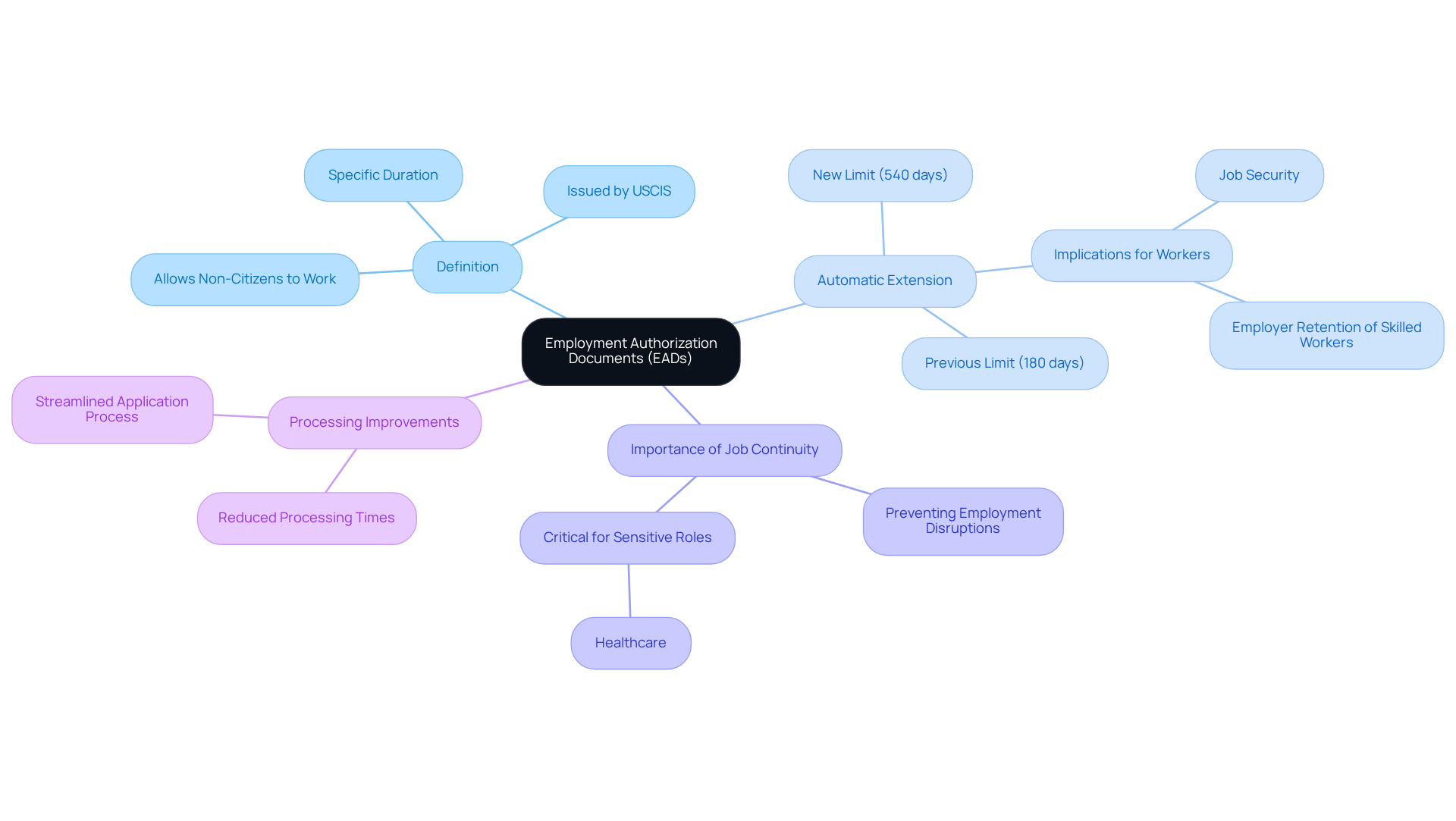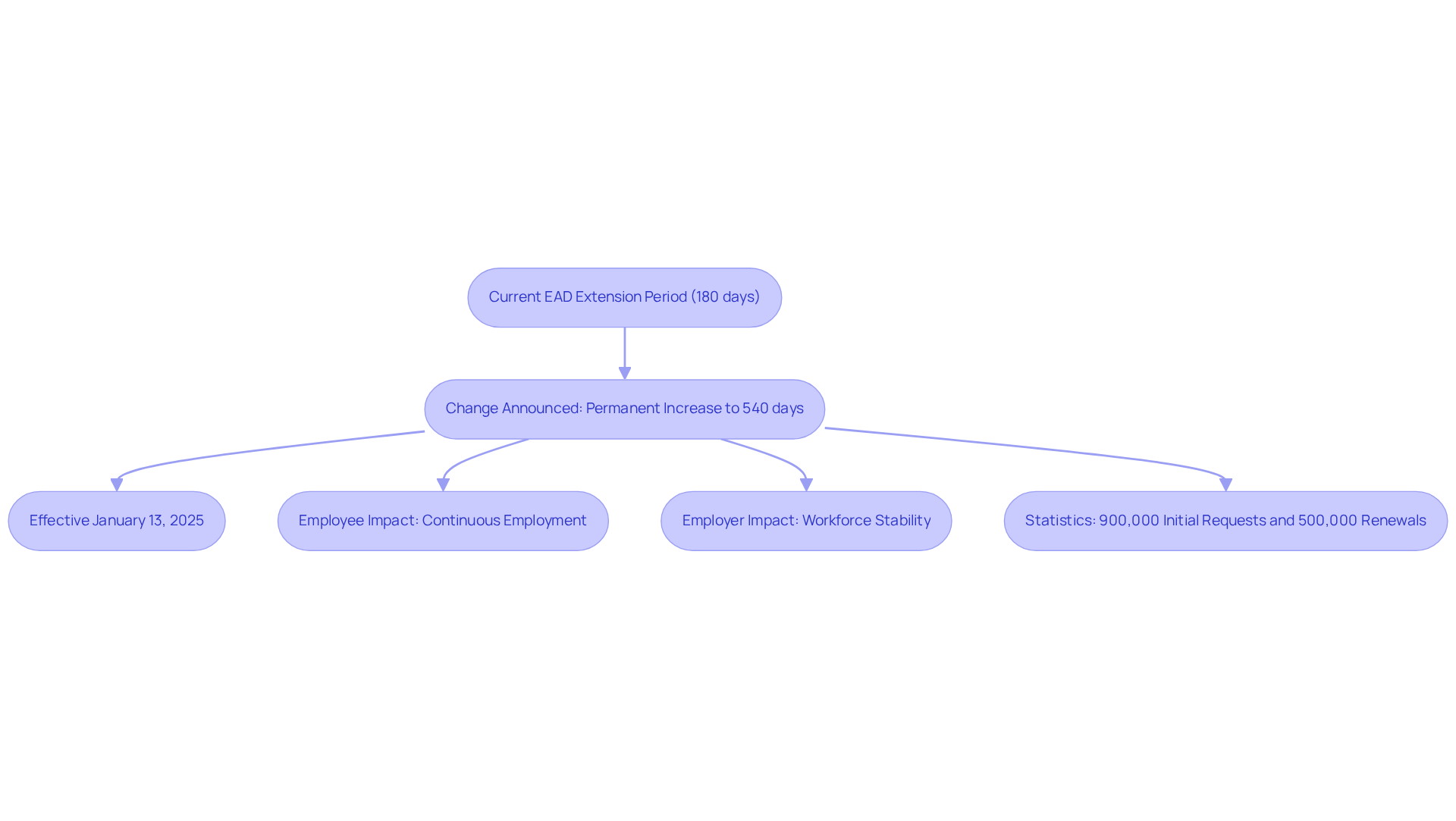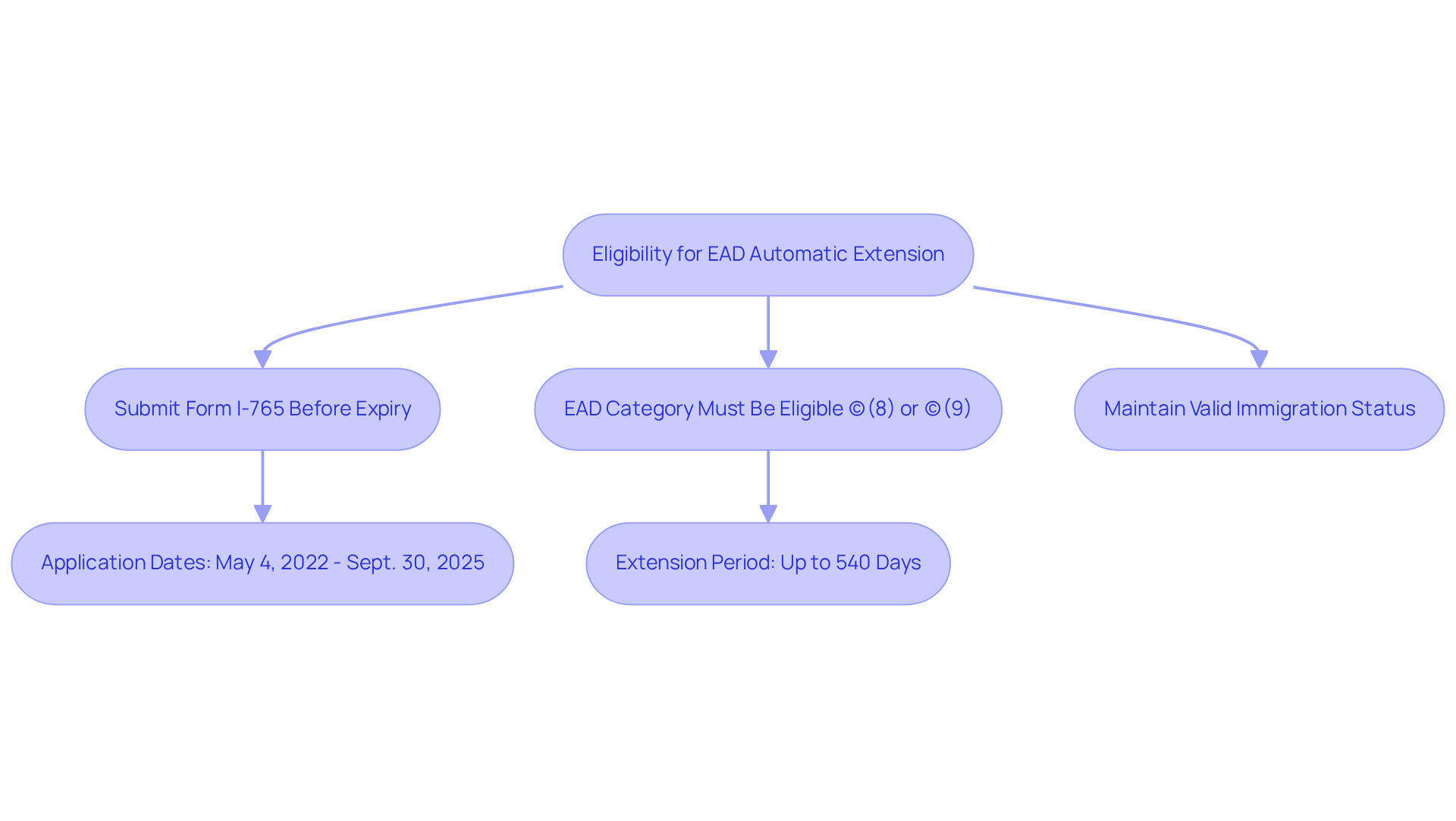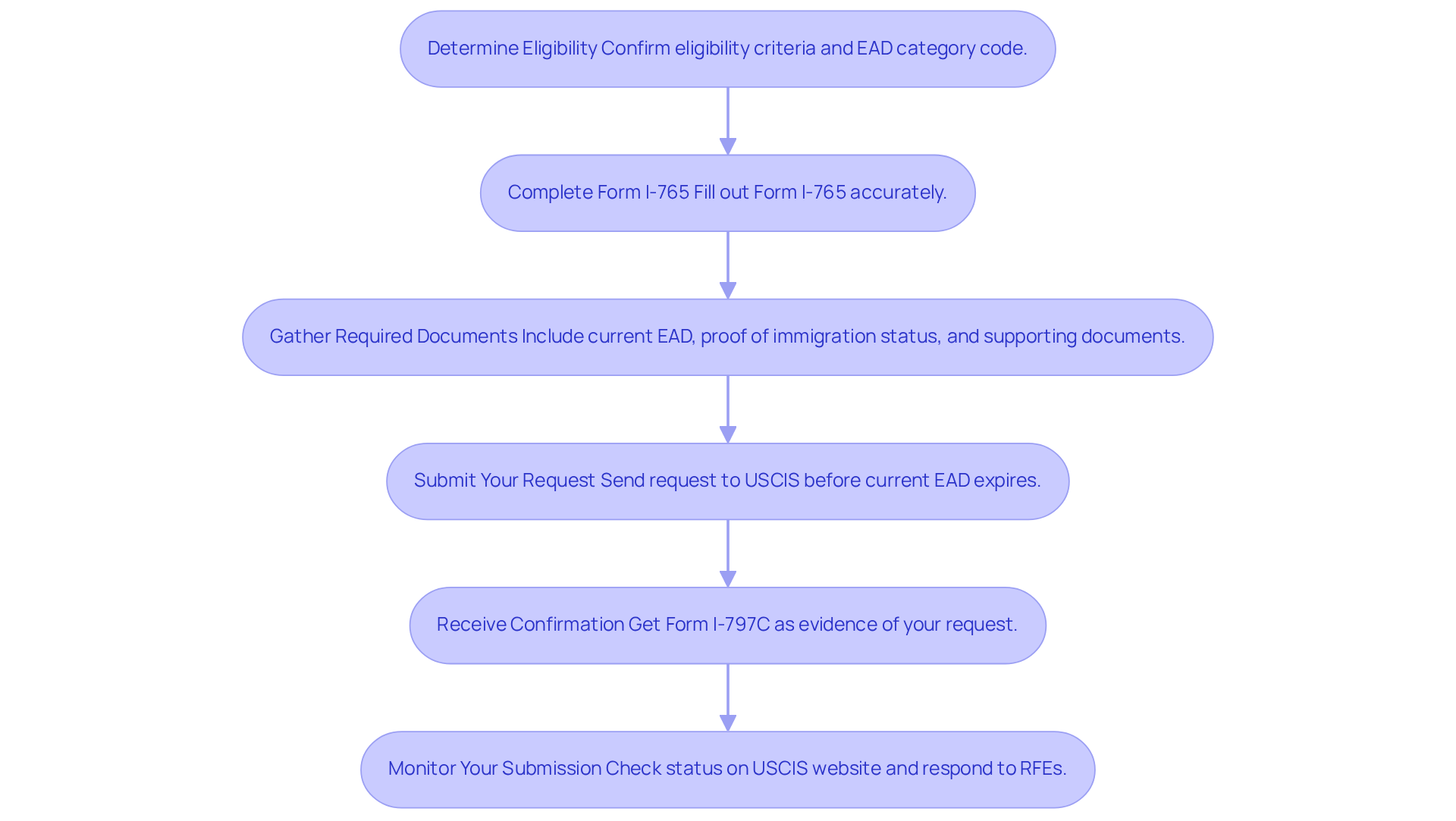Overview
The article highlights a crucial change to the Employment Authorization Document (EAD) automatic extensions that will significantly impact eligible applicants.
Starting January 13, 2025, they will enjoy a permanent increase in the automatic extension period from 180 days to 540 days. This change aims to alleviate the employment disruptions many face due to processing delays, offering job security for workers and stability for employers.
The Department of Homeland Security is committed to reducing barriers in the immigration system, ensuring that you are not alone in this fight for your rights and future.
Introduction
As the landscape of employment authorization evolves, the introduction of automatic extensions for Employment Authorization Documents (EADs) represents a crucial shift for non-citizens working in the United States. Starting January 13, 2025, eligible individuals will enjoy an extended automatic renewal period of up to 540 days. This significant improvement aims to reduce job disruptions during processing delays.
Yet, with this new opportunity comes the challenge of navigating the complexities of eligibility and application procedures. How can workers and employers leverage this extension to ensure uninterrupted employment and stability in the workforce?
We understand how overwhelming this feels, but you don’t have to face it alone—we’ll guide you every step of the way.
Define Employment Authorization Documents and Automatic Extensions
Employment Authorization Documents (EADs) are vital legal tools issued by the U.S. Citizenship and Immigration Services (USCIS), allowing non-citizens to work in the United States for a specific duration. The EAD automatic extension clause is a game-changer, allowing qualified EAD holders to keep their jobs past the expiration date of their EAD while their renewal request is being processed. This is crucial for preventing employment disruptions, especially for those in sensitive roles like healthcare, where job continuity is essential.
Starting January 13, 2025, eligible applicants can enjoy an EAD automatic extension of up to 540 days—a significant increase from the previous limit of 180 days. This change alleviates the anxiety of potential job loss due to processing delays and helps employers retain skilled workers, contributing to overall workforce stability.
As Emily M. Dickens, SHRM chief of staff, pointed out, "This critical step addresses a significant barrier in the U.S. workplace immigration system by helping to prevent unnecessary lapses in work authorization due to processing delays."
Furthermore, case studies indicate that USCIS has implemented measures to reduce processing times for EAD requests, enhancing the immigration system's effectiveness. Qualified workers must ensure they submit their reauthorization requests promptly to take advantage of this prolongation, which is essential for preserving their job status.

Explore the Permanent Increase of the Automatic Extension Period
The Department of Homeland Security (DHS) has announced a significant change: the EAD automatic extension period for Employment Authorization Documents (EADs) will now be permanently increased from 180 days to 540 days, starting January 13, 2025. This crucial adjustment aims to ease the burden on employees and employers alike by greatly reducing the risk of employment gaps due to EAD automatic extension processing delays. To qualify, candidates must have submitted their Form I-765, Request for Employment Authorization, for extension. This regulation applies to those with pending or submitted requests on or after May 4, 2022. With this extended period, individuals can maintain their employment status while waiting for their EAD automatic extension application for reissue, which often takes several months.
The impact of this extension is profound. For employees, it serves as a safety net, ensuring they can continue working without interruption during the reapplication process. For employers, this change fosters workforce stability, allowing businesses to maintain productivity and avoid disruptions caused by lapses in work authorization. As of fall 2024, approximately 900,000 individuals are waiting for their initial EAD requests to be processed, with an additional 500,000 pursuing renewals. This statistic underscores the importance of this addition in addressing the ongoing challenges of application backlogs. Moreover, DHS's decision to implement this change responds to feedback from the business community, highlighting the need for greater certainty for employers. This rule not only supports individual workers but also contributes to overall economic stability by allowing a skilled workforce to remain engaged in their roles. As emphasized by DHS, this regulation transitions the 540-day extension from a temporary measure to a permanent benefit, reflecting a commitment to reducing obstacles within the immigration system.

Identify Eligibility Requirements for Automatic EAD Extensions
Navigating the complexities of the Employment Authorization Document (EAD) process can be daunting. To qualify for the EAD automatic extension, applicants must meet specific eligibility criteria:
- You need to submit Form I-765 for reissuance before your current EAD expires.
- Your EAD must belong to a category eligible for an EAD automatic extension, such as (c)(8) for asylum seekers or (c)(9) for those adjusting status.
- It's essential to maintain valid immigration status throughout the reapplication process.
Confirming your EAD category codes is crucial to ensure compliance with the EAD automatic extension requirements, helping prevent any lapses in your employment authorization. Remember, qualified applicants must have submitted a reapplication between May 4, 2022, and September 30, 2025. This change reflects ongoing improvements in processing times and extends the automatic reactivation period to 540 days, effective January 13, 2025, as part of a final rule published on December 13, 2024. Secretary Alejandro N. Mayorkas emphasized, "Increasing the EAD automatic extension period for certain employment authorization documents will help eliminate red tape that burdens employers, ensuring hundreds of thousands of individuals eligible for employment can continue to contribute to our communities." Real-life examples of applicants meeting these criteria can further illustrate the practical implications of these changes, reminding us: we’re in this fight together.

Guide to Applying for EAD Renewals and Managing Extensions
Applying for EAD renewals can feel daunting, but understanding the essential steps can make the process smoother:
- Determine Eligibility: Confirm that you meet the eligibility criteria for the EAD automatic extension and ensure your EAD category code is correct.
- Complete Form I-765: Fill out Form I-765 accurately, making sure all information is complete and correct to avoid delays.
- Gather Required Documents: Include necessary documentation such as a copy of your current EAD, proof of immigration status, and any additional supporting documents.
- Submit Your Request: Send your request to USCIS, either online or by mail, and ensure it is postmarked before your current EAD expires to qualify for automatic renewal.
- Receive Confirmation: After submission, you will receive a Form I-797C, Notice of Action, which serves as evidence of your request and allows you to work under the automatic prolongation while your application is processed.
- Monitor Your Submission: Regularly check your status on the USCIS website and be prepared to respond promptly to any Requests for Evidence (RFEs) to avoid unnecessary delays.
Common mistakes in EAD reapplication include submitting late, which negates the benefit of the 540-day automatic extension, and inaccuracies in the provided information. In 2025, timely submissions have a success rate of approximately 80%, significantly enhancing your chances of approval. This statistic is based on the national average processing time for 80% of applicants, which is around 6.4 months. Successful EAD application submissions highlight the importance of following these guidelines and maintaining clear communication with USCIS. Additionally, it's crucial to submit extensions within 180 days of expiration to ensure ongoing work authorization. Keep in mind that processing times for H-4 dependent EADs can range from 4 to 12 months, potentially impacting your renewal timeline.

Conclusion
The forthcoming changes to the Employment Authorization Document (EAD) automatic extension policy represent a significant advancement for non-citizen workers in the United States. Starting January 13, 2025, eligible applicants will benefit from an extended automatic extension period of up to 540 days. This substantial increase alleviates the stress of potential job loss during processing delays, supporting individual job security and enhancing workforce stability for employers. Together, these changes create a more resilient employment landscape.
Key points throughout this article highlight:
- Eligibility requirements for the automatic extension
- Procedural steps for applying for EAD renewals
- The broader implications of these changes on the U.S. workforce
The emphasis on timely submission of Form I-765 and maintaining valid immigration status underscores the importance of proactive engagement in the renewal process. Moreover, the statistics illustrating the number of individuals awaiting EAD processing emphasize the necessity of this permanent change in addressing application backlogs and promoting economic stability.
In light of these developments, it is crucial for eligible applicants to stay informed and prepared. Understanding the EAD automatic extension process can significantly impact individual employment situations and contribute to a more stable workforce overall. As these changes take effect, individuals and employers alike are encouraged to leverage this opportunity to ensure continuous work authorization and enhance their contributions to the community. By remaining vigilant and proactive, the benefits of this reform can be fully realized, paving the way for a more secure future in the U.S. job market.
Frequently Asked Questions
What are Employment Authorization Documents (EADs)?
Employment Authorization Documents (EADs) are legal tools issued by the U.S. Citizenship and Immigration Services (USCIS) that allow non-citizens to work in the United States for a specific duration.
What is the EAD automatic extension clause?
The EAD automatic extension clause allows qualified EAD holders to continue working past the expiration date of their EAD while their renewal request is being processed, preventing employment disruptions.
When will the new EAD automatic extension period take effect?
Starting January 13, 2025, eligible applicants can benefit from an EAD automatic extension of up to 540 days, an increase from the previous limit of 180 days.
Why is the EAD automatic extension important?
The EAD automatic extension is important because it alleviates concerns about potential job loss due to processing delays, helping employers retain skilled workers and contributing to overall workforce stability.
What measures has USCIS taken regarding EAD processing times?
USCIS has implemented measures to reduce processing times for EAD requests, which enhances the effectiveness of the immigration system.
What should qualified workers do to take advantage of the EAD automatic extension?
Qualified workers must ensure they submit their reauthorization requests promptly to benefit from the automatic extension and preserve their job status.




